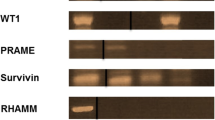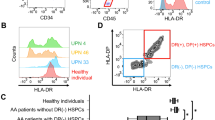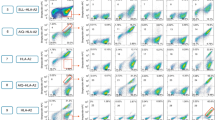Abstract
CML is characterized by the chromosomal translocation t(9;22) (q34;q11) resulting in the chimeric bcr-abl oncogene that encodes P210 fusion proteins with novel amino acid sequences in the breakpoint region. If these peptides derived from P210 are presented by HLA molecules on the cell membrane of leukemic cells an immunological response may occur. Recent studies using synthetic peptides identical to the bcr-abl fusion region revealed that some peptides are capable of binding to the class I molecules HLA-A2,-A3,-A11 and -B8 and the class II molecules HLA-DR1, -DR2, -DR3, -DR4 and -DR11. Moreover T cell responses have been induced against bcr-abl-derived synthetic peptides bound to some of these HLA molecules. For HLA class I, we have previously shown that individuals expressing HLA-A3 and -B8 have a diminished risk of development of CML. To assess a similar protective effect of class II molecules we performed a large multi-center study. This study compared the frequencies of HLA-DR1, -DR2, -DR3, -DR4 and -DR11 of patients with CML from the database of the EBMT (n = 1462) with unaffected individuals from the registry of Bone Marrow Donors Worldwide (n = 500 596). Patients and controls were matched per country. This analysis yielded significantly lower odds ratios (ORs) of 0.86 (95% CI 0.75–0.98) for HLA-DR3 and of 0.80 (95% CI 0.71–0.89) for HLA-DR4. The OR was 0.91 (95% CI 0.80–1.04) for HLA-DR1, 1.05 (95% CI 0.94–1.18) for HLA-DR2 and 0.87 (95% CI 0.74–1.01) for HLA-DR11. To assess a possible effect of the linkage disequilibrium between HLA-B8 and HLA-DR3 we found that coexpression of HLA-B8 and HLA-DR3 gave an OR of 0.84 (95% CI 0.72–0.98), whereas HLA-DR3 positive/HLA-B8 negative individuals showed an OR of 1.02 (95% CI 0.84–1.24). This means that the protective effect of HLA-DR3 of the development of CML was probably caused by its linkage disequilibrium with HLA-B8. In contrast, as there is no linkage disequilibrium of HLA-DR4 with HLA-A3 or HLA-B8, the results indicate that HLA-DR4 expression itself is associated with a diminished incidence of CML possibly by the presentation of bcr-abl breakpoint peptides in these HLA molecules on the membrane of the leukemic cells.
This is a preview of subscription content, access via your institution
Access options
Subscribe to this journal
Receive 12 print issues and online access
$259.00 per year
only $21.58 per issue
Buy this article
- Purchase on Springer Link
- Instant access to full article PDF
Prices may be subject to local taxes which are calculated during checkout

Similar content being viewed by others
References
Nowell PC, Hungerford DA . A minute chromosome in human chronic granulocytic leukemia Science 1960 132: 1497
Rowley JD . A new consistent abnormality in chronic myelogenous leukemia identified by quinacrine fluorescence and Giemsa staining Nature 1973 423: 290–293
Shtivelman E, Lifshitz B, Gale RP, Canaani E . Fused trancripts of abl and bcr genes in chronic myelogeous leukemia Nature 1985 315: 550–554
Kurzock R, Gutterman JU, Talpaz M . The molecular genetics of Philadelphia chromosome-positive leukemias New Engl J Med 1988 319: 990–998
Bocchia M, Wentworth PA, Southwood S, Sidney J, McGraw K, Scheinberg DA, Sette A . Specific binding of leukemia oncogene fusion protein peptides to HLA class 1 molecules Blood 1995 85: 2680–2684
Greco G, Fruci D, Accapezzato D, Barnaba V, Nisini R, Alimena G, Montefusco E, ButlerR, Tanigaki N, Tosi R . Two bcr-abl junction peptides bind HLA-A3 molecules and allow specific induction of human cytotoxic T lymphocytes Leukemia 1996 10: 693–699
Yotnda P, Firat H, Garcia-Pons F, Garcia Z, Gourru G, Vernant JP, Lemonnier FA, Leblond V, Langlade-Demoyen P . Cytotoxic T cell response against the chimeric p210 BCR-ABL protein in patients with chronic myelogenous leukemia J Clin Invest 1998 101: 2290–2296
Renaud M, Langlade-Demoyen P, Autran B, Leblond V . Evaluation of the protective effect of human cytotoxic lymphocytes (CTL) specific for p210 BCR-ABL protein in a SCID mouse model Hematol Cell Ther 1997 39: 87–89
Bocchia M, Korontsvit T, Xu Q, Mackinnon S, Yang SY, Sette A, Scheinberg DA . Specific human cellular immunity to bcr-abl oncogene-derived peptides Blood 1996 87: 3587–3592
Dermime S, Molldrem J, Parker KC, Jiang YZ, Mavoudis D, Hensel N, Couriel D, Mahoney M, Coligan JE, Barrett AJ . Human CD8+ T lymphocytes recognize the fusion region of BCR/ABL hybrid protein present in chronic myeloid leukemia Blood 1995 86: (Suppl) 158a
Posthuma EFM, Falkenburg JHF, Apperley JF, Roosnek E, Oudshoorn M, M, Schipper RF, Schreuder GMT, D'Amaro J, van Biezen JH, Hermans J, Willemze R, Niederwieser D . HLA-B8 and HLA-A3 in association with HLA-B8 is associated with a diminished incidence of chronic myeloid leukemia Blood 1999 93: 3863–3865
Mannering SI, McKenzie JL, Fearnley DB, Hart DNJ . HLA-DR1-restricted bcr-abl (b3a2)-specific CD4+ T lymphocytes respond to dendritic cells pulsed with b3a2 peptide and antigen-presenting cells exposed to b3a2 containing cell lysates Blood 1997 90: 290–297
ten Bosch GJA, Toornvliet AC, Friede T, Melief CJM, Leeksma OC . Recognition of peptides corresponding to the joining region of p210bcr-abl protein by human T cells Leukemia 1995 9: 1344–1348
ten Bosch GJA, Joosten AM, Kessler JH, Melief CJM, Leeksma OC . Recognition of BCR-ABL positive leukemic blasts by human CD4+ T cells elicited by primary in vitro immunization with a BCR-ABL breakpoint peptide Blood 1996 88: 3522–3527
Pawelec G, Max H, Halder T, Bruserud O, Merl A, da Silva P, Kalbacher H . BCR/ABL leukemia oncogene fusion peptides selectively bind to certain HLA-DR alleles and can be recognized by T cells found at low frequency in the repertoire of normal donors Blood 1996 88: 211–218
Schipper RF, Schreuder GMT, D'Amaro J, Oudshoorn M . HLA gene and haplotype frequencies in Dutch blood donors Tissue Antigens 1996 48: 562–574
Schipper RF, D'Amaro J, Bakker J, Rood JJ v, Oudshoorn M . HLA gene and haplotype frequencies in Bone Marrow Donors Worldwide registries Hum Immunol 1997 52: 54–71
BMDW Editorial board . Bone Marrow Donors Worldwide, edition 37 Europdonor Foundation: Leiden 1998
Woolf B . On estimating the relation between blood group and disease Ann Hum Genet 1955 19: 251–253
Haldane JBS . The estimation and significance of the logarithm of a ratio of frequencies Ann Hum Genet 1955 20: 309–311
Greenland S . Quantative methods in the review of epidemiologic literature Epidemiol Rev 1987 9: 1–30
Monaco JJ . A molecular model of MHC class-I-restricted antigen processing Immunol Today 1992 13: 173–179
Neefjes JJ, Ploegh HL . Intracellular transport of MHC class II molecules Immunol Today 1992 13: 179–184
Chicz RM, Urban RG, Gorga JC, Vignali DAA, Lane WS, Strominger JL . Specificity and promiscuity among naturally processed peptides bound to HLA-DR alleles J Exp Med 1993 178: 27–47
Jiang Y, Barrett AJ . Cellular and cytokine-mediated effects of CD4-positive lymphocyte lines generated in vitro against chronic myelogenous leukemia Exp Hematol 1995 23: 167–172
Author information
Authors and Affiliations
Consortia
Rights and permissions
About this article
Cite this article
Posthuma, E., Falkenburg, J., Apperley, J. et al. HLA-DR4 is associated with a diminished risk of the development of chronic myeloid leukemia (CML). Leukemia 14, 859–862 (2000). https://doi.org/10.1038/sj.leu.2401774
Received:
Accepted:
Published:
Issue Date:
DOI: https://doi.org/10.1038/sj.leu.2401774
Keywords
This article is cited by
-
Alternative Ii-independent antigen-processing pathway in leukemic blasts involves TAP-dependent peptide loading of HLA class II complexes
Cancer Immunology, Immunotherapy (2010)
-
Therapeutic use of Aldara™ in chronic myeloid leukemia
Journal of Translational Medicine (2007)
-
Association of HLA class II allele and haplotype frequencies with chronic myelogenous leukemia and age-at-onset of the disease
Pathology & Oncology Research (2007)
-
Association of HLA Class I and Class II genes with bcr-abl transcripts in leukemia patients with t(9;22) (q34;q11)
BMC Cancer (2004)
-
Is HLA-DR4 or the HLA-DRB1*0402 allele associated with decreased risk for CML?
Leukemia (2001)



